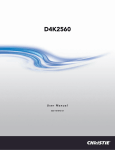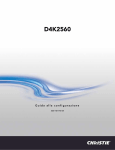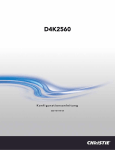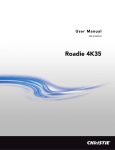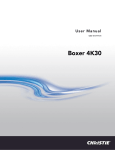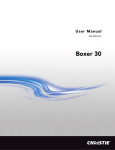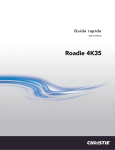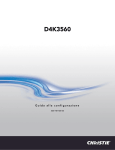Download Christie D4K2560 Setup guide
Transcript
D4K2560 Setup Guide 020-101171-01 D4K2560 Setup Guide 020-101171-01 NOTICES COPYRIGHT AND TRADEMARKS © 2013 Christie Digital Systems USA Inc. All rights reserved. All brand names and product names are trademarks, registered trademarks or trade names of their respective holders. REGULATORY The product has been tested and found to comply with the limits for a Class A digital device, pursuant to Part 15 of the FCC Rules. These limits are designed to provide reasonable protection against harmful interference when the product is operated in a commercial environment. The product generates, uses, and can radiate radio frequency energy and, if not installed and used in accordance with the instruction manual, may cause harmful interference to radio communications. Operation of the product in a residential area is likely to cause harmful interference in which case the user will be required to correct the interference at the user’s own expense. CAN ICES-3 (A) / NMB-3 (A) 이 기기는 업무용 (A 급 ) 으로 전자파적합등록을 한 기기이오니 판매자 또는 사용자는 이점을 주의하시기 바라며 , 가정 외의 지역에서 사용하는 것을 목적으로 합니다 . GENERAL Every effort has been made to ensure accuracy, however in some cases changes in the products or availability could occur which may not be reflected in this document. Christie reserves the right to make changes to specifications at any time without notice. Performance specifications are typical, but may vary depending on conditions beyond Christie's control such as maintenance of the product in proper working conditions. Performance specifications are based on information available at the time of printing. Christie makes no warranty of any kind with regard to this material, including, but not limited to, implied warranties of fitness for a particular purpose. Christie will not be liable for errors contained herein or for incidental or consequential damages in connection with the performance or use of this material. The product is designed and manufactured with high-quality materials and components that can be recycled and reused. This symbol means that electrical and electronic equipment, at their end-of-life, should be disposed of separately from regular waste. Please dispose of the product appropriately and according to local regulations. In the European Union, there are separate collection systems for used electrical and electronic products. Please help us to conserve the environment we live in! Canadian manufacturing facility is ISO 9001 and 14001 certified. GENERAL WARRANTY STATEMENTS For complete information about Christie’s limited warranty, please contact your Christie dealer. In addition to the other limitations that may be specified in Christie’s limited warranty, the warranty does not cover: a. Problems or damage occurring during shipment, in either direction. b. Projector lamps (See Christie’s separate lamp program policy). c. Problems or damage caused by use of a projector lamp beyond the recommended lamp life, or use of a lamp supplied by a supplier other than Christie. d. Problems or damage caused by combination of a Product with non-Christie equipment, such as distribution systems, cameras, video tape recorders, etc., or use of a Product with any non-Christie interface device. e. Problems or damage caused by the use of any lamp, replacement part or component purchased or obtained from an unauthorized distributor of Christie lamps, replacement parts or components including, without limitation, any distributor offering Christie lamps, replacement parts or components through the internet (confirmation of authorized distributors may be obtained from Christie). f. Problems or damage caused by misuse, improper power source, accident, fire, flood, lightening, earthquake or other natural disaster. g. Problems or damage caused by improper installation/alignment, or by equipment modification, if by other than Christie service personnel or a Christie authorized repair service provider. h. Problems or damage caused by use of a Product on a motion platform or other movable device where such Product has not been designed, modified or approved by Christie for such use. i. Problems or damage caused by use of a projector in the presence of an oil-based fog machine. j. For LCD projectors, the warranty period specified applies only where the LCD projector is in “normal use.” “Normal use” means the LCD projector is not used more than 8 hours a day, 5 days a week. For any LCD projector where “normal use” is exceeded, warranty coverage under this warranty terminates after 6000 hours of operation. k. Image retention on LCD flat panels. l. Failure due to normal wear and tear. PREVENTATIVE MAINTENANCE Preventative maintenance is an important part of the continued and proper operation of your product. Please see the Maintenance section for specific maintenance items as they relate to your product. Failure to perform maintenance as required, and in accordance with the maintenance schedule specified by Christie, will void the warranty. Introduction . . . . . . . . . . . . . . . . . . . . . . . . . . . . . . . . . . . . . . . . . . . . . . . . . . . . . 1 Safety and Warning Guidelines . . . . . . . . . . . . . . . . . . . . . . . . . . . . . . . . . . . . . . . 1 AC/Power Precautions . . . . . . . . . . . . . . . . . . . . . . . . . . . . . . . . . . . . . . . . . . . 2 Lamp Precautions . . . . . . . . . . . . . . . . . . . . . . . . . . . . . . . . . . . . . . . . . . . . . . 2 Product Safety Labels . . . . . . . . . . . . . . . . . . . . . . . . . . . . . . . . . . . . . . . . . . . 3 Projector Overview . . . . . . . . . . . . . . . . . . . . . . . . . . . . . . . . . . . . . . . . . . . . . . . 4 Contact Your Dealer .............................................. 4 List of Components . . . . . . . . . . . . . . . . . . . . . . . . . . . . . . . . . . . . . . . . . . . . . . . 5 Site Requirements . . . . . . . . . . . . . . . . . . . . . . . . . . . . . . . . . . . . . . . . . . . . . . . . 7 Physical Operating Environment . . . . . . . . . . . . . . . . . . . . . . . . . . . . . . . . . . . . . . 7 External Exhaust Ducting . . . . . . . . . . . . . . . . . . . . . . . . . . . . . . . . . . . . . . . . . . . 7 Power Connection . . . . . . . . . . . . . . . . . . . . . . . . . . . . . . . . . . . . . . . . . . . . . . . . 7 Tools Required for Installation. . . . . . . . . . . . . . . . . . . . . . . . . . . . . . . . . . . . . . 7 Projector Components . . . . . . . . . . . . . . . . . . . . . . . . . . . . . . . . . . . . . . . . . . . . 8 Installation Safety and Warning Guidelines . . . . . . . . . . . . . . . . . . . . . . . . . . . 9 Position the Projector . . . . . . . . . . . . . . . . . . . . . . . . . . . . . . . . . . . . . . . . . . . . 10 Connect to AC Power . . . . . . . . . . . . . . . . . . . . . . . . . . . . . . . . . . . . . . . . . . . . 11 Adjust the Projector Tilt and Level . . . . . . . . . . . . . . . . . . . . . . . . . . . . . . . . . 13 Install the Touch Panel Controller (TPC). . . . . . . . . . . . . . . . . . . . . . . . . . . . . 14 Connect External Exhaust Ducting . . . . . . . . . . . . . . . . . . . . . . . . . . . . . . . . . 15 Lens Setup . . . . . . . . . . . . . . . . . . . . . . . . . . . . . . . . . . . . . . . . . . . . . . . . . . . . . 16 Calibrate the Lens Motors . . . . . . . . . . . . . . . . . . . . . . . . . . . . . . . . . . . . . . . . . .17 Lamp Setup . . . . . . . . . . . . . . . . . . . . . . . . . . . . . . . . . . . . . . . . . . . . . . . . . . . . 17 Connect Devices . . . . . . . . . . . . . . . . . . . . . . . . . . . . . . . . . . . . . . . . . . . . . . . . 18 Connect a Video Source via 3G-SDI . . . . . . . . . . . . . . . . . . . . . . . . . . . . . . . . . . . .18 Connect a Video Source via DisplayPort . . . . . . . . . . . . . . . . . . . . . . . . . . . . . . . . .19 Connect a Video Source via DVI . . . . . . . . . . . . . . . . . . . . . . . . . . . . . . . . . . . . . .19 Connect a Computer or Server . . . . . . . . . . . . . . . . . . . . . . . . . . . . . . . . . . . . . . .19 Ethernet Setup . . . . . . . . . . . . . . . . . . . . . . . . . . . . . . . . . . . . . . . . . . . . . . . . . .20 Touch Panel Controller (TPC). . . . . . . . . . . . . . . . . . . . . . . . . . . . . . . . . . . . . . 21 D4K2560 Setup Guide 020-101171-01 Rev. 1 (06-2013) i Introduction This manual is intended for professionally trained operators of Christie high-brightness projection systems. These operators are qualified to replace the lamp and air filter, but should not attempt to install or service the projector. Only accredited Christie technicians who are knowledgeable about the hazards associated with high-voltage, ultraviolet exposure, and the high temperatures generated by the projector lamp are authorized to assemble, install, and service the projector. Safety and Warning Guidelines This projector must be operated in an environment that meets the operating range specification. Use only the attachments and/or accessories recommended by Christie. Use of others may result in the risk of fire, shock or personal injury. Failure to comply with the following could result in death or serious injury: • Never look directly into the projector lens or at the lamp. The extremely high brightness can cause permanent eye damage. For protection from ultraviolet radiation, keep all projector housings intact during operation. Protective safety gear and safety goggles are recommended when servicing. • FIRE HAZARD! Keep hands, clothes, and all combustible material away from the concentrated light beam of the lamp. Failure to comply with the following could result in minor or moderate injury: • Position all cables where they cannot contact hot surfaces or be pulled or tripped over. • The American Conference of Governmental Industrial Hygienists (ACGIH) recommends occupational UV exposure for an 8-hour day to be less than 0.1 microwatts per square centimeters of effective UV radiation. A workplace evaluation is advised to assure employees are not exposed to cumulative radiation levels exceeding the government guidelines for your area. Be aware that some medications are known to increase sensitivity to UV radiation. NOTE: During maintenance and cleaning operations, the instructions define that the unit is not to be operational, thus the lamps will not be active and there will be no emissions. D4K2560 Setup Guide 020-101171-01 Rev. 1 (06-2013) 1 Introduction AC/Power Precautions To correctly install this projector, a certified electrician must install a permanent connection to the projector head. Operate the projector at the recommended voltage. Disconnect projector from AC before opening any enclosure. Failure to comply results in death or serious injury. Failure to comply with the following could result in death or serious injury: • Verify that the projector is using a line cord, socket and power plug that meets the appropriate local rating standards. Use only an AC power cord recommended by Christie. Do not attempt operation if the AC supply and cord are not within the specified voltage and power range. • DO NOT allow anything to rest on the power cord. Locate the projector where the cord cannot be abused by persons walking on it or objects rolling over it. Never operate the projector if the power cable appears damaged in any way. • DO NOT overload power outlets and extension cords as this can result in fire or shock hazards. Lamp Precautions Lamps used in the projector are under high pressure and must be handled with caution. Lamps can explode and cause serious personal injury if they are dropped or mishandled. Failure to comply with the following results in death or serious injury: • Never attempt to access the lamp compartment while the lamp is On. Wait at least 10 minutes after the lamp turns Off before powering down, disconnecting from AC and opening the lamp door. • The arc lamp operates at a high pressure that increases with temperature. Failure to allow the lamp to sufficiently cool before handling, increases the potential for an explosion causing personal injury or property damage. • Always wear manufacturer approved protective safety clothing (gloves, jacket, face shield) whenever the lamp door is open or when handling the lamp. Only qualified technicians should install projector lamps. Failure to comply with the following could result in death or serious injury: • Possibly hazardous optical radiation emitted from this product. (Risk group 3) • Thermal radiation emitted from this product may cause burns. (Risk group 3) i Recommended protective clothing includes, but may not be limited to a polycarbonate face shield, protective gloves, and a quilted ballistic nylon jacket or a welder’s jacket. This equipment is included in included in the Christie Protective Clothing Safety Kit P/N: 598900-095. Christie’s protective clothing recommendations are subject to change. Any local or federal specifications take precedence over Christie recommendations. 2 D4K2560 Setup Guide 020-101171-01 Rev. 1 (06-2013) Introduction Product Safety Labels Indicates the presence of a grounding point. Indicates the presence of an earth grounding point. Indicates the presence of a dangerous condition or situation. Indicates the presence of a pinch hazard. To avoid personal injury, keep hands clear and loose clothing tied back. Indicates the presence of a hot surface. To avoid personal injury, always allow the projector to cool down for a minimum of 10 minutes before performing maintenance or service procedures. Indicates the presence of a hot surface. To avoid personal injury, always allow the projector to cool down for a minimum of 10 minutes before performing maintenance or service procedures. Indicates the presence of an electrical shock hazard. To avoid personal injury, always disconnect all power sources before performing maintenance or service procedures. Indicates the presence of an electrocution hazard. To avoid personal injury, always disconnect all power sources before performing maintenance or service procedures. Indicates the presence of moving fan blades. To avoid personal injury, keep hands clear and loose clothing tied back. Always disconnect all power sources before performing maintenance or service procedures. Indicates exposure to bright light. To avoid personal injury, do not look directly at the light source. Indicates the presence of an explosion hazard. To avoid personal injury, always disconnect all power sources and wear Christie approved protective clothing. Indicates the presence of a fire hazard. To avoid personal injury and property damage, always adhere to the instructions described in this manual. D4K2560 Setup Guide 020-101171-01 Rev. 1 (06-2013) 3 Introduction Always disconnect all power sources before performing maintenance or service procedures. See the product user manual for specific information and directions. See the product service manual for specific information and directions. Do not look directly into the lens. Projector Overview The D4K2560 is a professional quality, easy-to-use projector utilizing Digital Light Processing (DLP™) technology from Texas Instruments. Integrating smoothly into traditional projection environments; The D4K2560 offers stunning wide screen, high-resolution 4K images at 60 frames per second. Contact Your Dealer If you encounter a problem with your Christie projector, contact your dealer. To assist with the servicing of your projector, enter the information in the tables below and keep this information with your records. Purchase Record Dealer: Dealer or Christie Sales/Service Contact Phone Number: Projector Serial Number: Purchase Date: Installation Date: *The serial number can be found on the license label located on the front panel Ethernet Settings Default Gateway Projector IP Address Subnet Mask 4 D4K2560 Setup Guide 020-101171-01 Rev. 1 (06-2013) Introduction List of Components Verify the following components were received with the projector: • Touch Panel Controller (TPC) • Lens plug (required for shipping when lens is not installed to prevent contamination of critical optical components) • Light engine removal tool • Convergence tool • Nylon safety strap with clip (required to secure projector to tabletop or optional rack mount) • Warranty Card • Shroud • Low Security Keys • Web Registration Form D4K2560 Setup Guide 020-101171-01 Rev. 1 (06-2013) 5 Site Requirements Physical Operating Environment • Maximum Ambient Temperature (operating) 35°C (95°F) • Minimum Ambient Temperature (operating) 10°C (50°F) External Exhaust Ducting The installation site must provide a minimum of 450 CFM (ft 3/min) external exhaust airflow to ensure adequate cooling of the Xenon arc lamp at less than or equal to 25°C (77°F) ambient and less than 3,000 ft (914.4 m) elevation. Above 25°C or 3,000 ft, 600 CFM is required. For CFM measuring instructions, see Connect External Exhaust Ducting on page 15. Power Connection i The requirements listed below are applicable for permanently wired installation or power cord connection. • Terminal block, electrician hard-wired to the projector head. • Electrical rating: 200 - 240 VAC, 23 A max. • This product can be connected to an IT power distribution system. Tools Required for Installation • 12” screwdrivers: Phillips #2 (magnetic) and flat • 19mm and 7/8” wrenches • Assorted Allen keys (metric) • Christie approved protective safety clothing if working with the lamp • Lens cleaning tissue and solution D4K2560 Setup Guide 020-101171-01 Rev. 1 (06-2013) 7 Projector Components Projector Components D LAMP SIDE C F E B A G J H LENS SIDE I ID 8 Item Description A Touch Panel Controller (TPC) The TPC is a touch-sensitive screen used to control and monitor operation. For information about TPC controls and settings. B LED Status Indicators LED color and blinking rates provide information about the status of the projector. For information about projector states and status, see the D4K2560 User Manual (P/N: 020-101076-01). C Manual Douser Override Closing the douser rotates a shutter blade in front of the lamp and reduces the lamp power to 2.0 kW to conserve lamp life. The override is for emergency use only. D Lamp Door and Lamps The lamp door provides access to the lamp compartment and must remain closed and locked for normal operation. Lamp replacement should only be performed by qualified technicians. For a complete list of available lamp types, see the D4K2560 User Manual (P/N: 020-101076-01). E Exhaust Duct and Vane Switch Extracts heated air from the lamp compartment. The vane switch mounted inside the rigid port monitors airflow. See Site Requirements on page 7. F Liquid Cooling Air Filter Cover and Air Filter Filters air before it circulates to cool the heat exchanger. G Shroud (2-piece) Covers the motorized lens mount assembly. H Projection Lens A variety of lenses can be used with the D4K2560. For a list of available lenses, see the D4K2560 User Manual (P/N: 020-101076-01). I Air Filter Cover and Air Filter Filters the intake air before it circulates through the front compartment to cool the main electronics. J Input Panel Faceplate Provides a variety of ports for connecting external devices. For information about connecting devices and inputs, see Connect Devices on page 18. D4K2560 Setup Guide 020-101171-01 Rev. 1 (06-2013) Installation Safety and Warning Guidelines Installation Safety and Warning Guidelines Failure to comply with the following results in death or serious injury: • This product must be installed within a restricted access location which is normally inaccessible by the general public, including workers, visitors and residents in the immediate vicinity, by means of engineering or administrative control measures but is accessible to authorized personnel that may not have specific safety training. • This product must be located and positioned in a way as to restrict audience members from direct access to enter the light beam path. • The projector uses a high-pressure lamp that may explode if improperly handled. Always wear manufacturer approved protective safety clothing (gloves, jacket, face shield) whenever the lamp door is open or when handling the lamp. Failure to comply results in death or serious injury. Failure to comply with the following could result in death or serious injury: • A qualified technician is required for all installations. • SHOCK HAZARD. Never operate the projector without all of it’s covers in place. • Use of the projector’s rear safety strap is mandatory to prevent the projector from tipping. Secure the strap between the projector and the optional rack stand, or to any other surface it is mounted. • Four or more people are required to safely lift and hand-carry one projection head a short distance. Recommend removing the lamp before transporting the projector. Failure to comply with the following may result in equipment damage: • Perform an automatic LampLOC adjustment when the lamp is moved, leveled, or a new lamp is installed in the projector. • Keep the projector level when lifting or transporting. Avoid tilting the projector to the right. This can introduce an air bubble into the coolant hoses that can result in an air lock and the overheating of the projector. D4K2560 Setup Guide 020-101171-01 Rev. 1 (06-2013) 9 Position the Projector Position the Projector i Keep the projector lens as parallel to the screen as possible, even if significantly above the screen center. When a particularly short throw distance combines with a very wide screen, you may have to forfeit some aim and stay more parallel to the screen. In such cases, some lens offset can reduce the keystone distortion. 1. Position the projector at an appropriate throw distance (projector-to-screen distance) and vertical position. Ideally, center the projector with the screen. If space is limited, aim the projector slightly off-center. This increases side keystoning, but reduces the horizontal lens offset required. 90° ≠90° If using an optional rack stand (P/N: 108-282101-02), assemble the rack stand using the instructions provided with the rack stand. Use the hold down clamp (P/N: 116-100101-01) when securing the projector to the rack stand. 10 D4K2560 Setup Guide 020-101171-01 Rev. 1 (06-2013) Connect to AC Power Connect to AC Power Failure to comply with the following could result in death or serious injury: • Certified electrician required during installation. Ground (earth) connection is necessary for safety. Never compromise safety by returning the current through the ground. Connect ground FIRST to reduce shock hazard. • Use an appropriate strain relief connector on the AC supply cable to prevent the cable from rubbing against the LPS knockout plate and becoming damaged. When connecting the projector directly to AC power, follow all electrical codes for your location. In addition, follow these recommendations: • Use 10AWG or 8AWG wiring. The distance between the wall circuit breaker and the projector must not exceed 20 meters using 10AWG cables or 30 meters using 8AWG cables. • For North American installations, use at least 10AWG copper wires for the connection of the main AC supply to the projector’s ground lug. • Copper or aluminum are acceptable as conductor wiring material to the terminal block. When connecting the projector to AC power with a pluggable type-B cable, follow all electrical codes for your location. In addition, follow these recommendations: • There must be easy access to the current protection device or breaker in the building. • Use minimum 10AWG wiring, with a maximum length of 4.5 m for U.S and Canada. For international installations the length should be based on the local electrical codes. • The socket-outlet is installed near the equipment and is easily accessible. • The plug can be used as the device disconnect and is near the unit and easily accessible. The circuit breaker on the projector baseplate (located under the front lens-side corner) can also be used as a means of disconnect. 1. On the bottom of the projector in the front lamp-side corner, loosen the 2 screws and slide the access panel to expose the terminal block. 2. Remove 4 screws securing the knockout plate to the bottom right corner of the front bezel. Remove the knockout plate. The AC supply is routed to the terminal block through an appropriate strain relief mounted on this knockout plate. 2 D4K2560 Setup Guide 020-101171-01 Rev. 1 (06-2013) 1 11 Connect to AC Power 3. Connect to the terminal block. NOTE: The terminal block accommodates up to an 8 AWG wire. If desired, a 90° strain relief connector can be used to route the power cable in a downward direction. Always connect the ground lead first to reduce shock hazard. • If connecting to permanent power, connect the AC power source to the terminal block, beginning with the ground lead. • If connecting to a pluggable type-B cable, connect the cable to the terminal block, beginning with the ground lead. • Use an appropriately sized strain relief connector with the knockout plate provided to ensure adequate environmental sealing and to prevent the cables from wear and accidentally being torn out. 3 4. Reinstall the knockout plate and secure it with 4 screws. 5. Reinstall the bottom access panel over the terminal block and secure it with 2 screws. 6. If using a pluggable type-B cable, connect to the building’s AC power source. 12 D4K2560 Setup Guide 020-101171-01 Rev. 1 (06-2013) Adjust the Projector Tilt and Level Adjust the Projector Tilt and Level The projector’s rear safety strap must be in place before adjusting the projector feet. Do not over-extend the feet. Make sure several threads are engaged into the projector’s baseplate to secure the projector from falling. Failure to comply could result in death or serious injury. The D4K2560 lens should be centered and parallel with the screen. This orientation ensures ideal lens performance with minimal offset. If this position is not possible (such as when the projector is significantly higher than the center of the screen), it is better to rely on offset rather than extra tilt. Use a protractor to measure the degree of screen tilt and then extend or retract the projector feet to match this angle. The front-to-back tilt of the projector must not exceed 15 degrees. This limit ensures safe lamp operation and the proper positioning of the liquid cooling reservoir. Failure to comply may result in equipment damage. To adjust the vertical or horizontal position of the projector, extend or retract the adjustable feet on the bottom of the projector by rotating them (A). Once the required adjustment is made, tighten the lock nut (B). B The D4K2560 projector provides 3.5 inches of adjustment at the front and 11.5 inches of adjustment at the rear. If the vertical or horizontal position of the projector requires more adjustment than the standard feet allow, two 6-inch extension rods can be installed to increase the amount of available adjustment. A Install the Foot Extension Rods 1. Prop up the rear of the projector to access the 2 rear feet. 2. Remove the feet by loosening the lock nut and rotating the each foot out of the projector. 3. Add the extension rods to the standard feet. 4. Thread the extended feet into the projector’s baseplate. 5. Adjust the feet until the desired tilt is achieved. 6. Lock the feet in place by turning each lock nut until it fits tight against the projector. 3 2 1 D4K2560 Setup Guide 020-101171-01 Rev. 1 (06-2013) 19 mm 13 Install the Touch Panel Controller (TPC) Install the Touch Panel Controller (TPC) 1. Loosen the mounting arm just enough for the end to fit over the ball joint located on the rear panel of the projector. 2. Tighten the mounting arm until it fits tightly on the joint. 3. Connect the cable from the TPC to the connector on the rear panel of the projector. 4. Adjust the TPC angle for optimal viewing. 14 D4K2560 Setup Guide 020-101171-01 Rev. 1 (06-2013) Connect External Exhaust Ducting Connect External Exhaust Ducting At minimum, a 10-inch (25.4 cm) long, strong metal duct must be installed at the projector and installed to an outside venting duct system to prevent glass shards from exiting the duct in the event of a lamp explosion. Failure to comply could result in death or serious injury. *600 CFM is required in projection rooms with an ambient temperature above 25°C or located at an elevation greater than 3000 feet above sea level. Failure to comply may result in equipment damage. Connect the existing outside-venting duct to the 8-inch diameter exhaust port on the top of the projector. Make sure there are no obstructions or bends in the ducting or air intakes and the vane switch at the exit duct moves freely. The pre-installed outside-venting duct should be rigid at the projector and must also include a heat extractor and blower that maintains a minimum of 450 CFM* when the projector is operating at less than or equal to 25°C (77°F) ambient and less than 3,000 feet (914.4 m), when measured at the projector exhaust opening. To determine the projector exhaust CFM value, use an airflow meter to measure the ft/min at the rigid end of the open exhaust duct that connects to the projector. Take the measurement at the very end of the duct without the projector connected. Use this formula to determine the CFM value for the projector: CFM = 0.35 Measured ft/min Lamp Type Min. Airflow (CFM) Required 2.0 kW 450 CFM* 3.0 kW 450 CFM* *600 CFM is required in projection rooms with ambient temperature above 25°C (77°F) or elevation (above sea level) greater than 3000 feet (914.4 m). Add an extractor or a booster if there is insufficient airflow. Do not mount the extractor on the projector as this may introduce some vibration into the image. Never disable the vane switch. Attempting to operate the projector with inadequate airflow can result in dangerous overheating of the projector. Failure to comply may result in equipment damage. i To prevent the projector from overheating or becoming unsafe, an alarm condition will be triggered on the TPC if the duct is obstructed or a fan fails. It is recommended to regularly verify that the exhaust is unobstructed and functioning correctly. D4K2560 Setup Guide 020-101171-01 Rev. 1 (06-2013) 15 Lens Setup Lens Setup Keep fingers and other body parts away from the moving parts in the projector. Motors and fans may start without warning. Tie back long hair, remove jewelry and loose clothing before manually adjusting the projector. Failure to comply could result in death or serious injury. The primary lens seals the projection head, preventing contaminants from entering the main electronics area. Do not operate the projector without a lens installed. Use a lens plug when installing or transporting the projector. Failure to comply may result in equipment damage. i The lens system controls the physical positions of the lens using 3 motors. The motors can be moved manually but software has been provided to allow for accurate and remote control of the lens positions. For details, see the D4K2560 User Manual (P/N: 020-101076-01). 1. Use finger pressure to push down on the shroud clips, as shown by the red arrows. 2. Carefully slide the shroud sideways and forward away from the lens mount, as shown by the black arrows. 3. Make sure the lens locking lever is in the UP position. 4. If attached, remove the rear lens cap from the lens. 5. Slide the lens into the lens mount, aligning all connections. NOTE: Always install the lens with “UP” label in the top position. This will assist in achieving consistent boresight alignment each time the lens is replaced. 2 1 6. Secure the lens with the lens locking lever (DOWN position). 7. Calibrate the lens motors. See Calibrate the Lens Motors on page 17. 16 D4K2560 Setup Guide 020-101171-01 Rev. 1 (06-2013) Lamp Setup Calibrate the Lens Motors If the lens motors are not calibrated properly, implications may include: • Incorrect reporting of the lens motor position. • Inability to use the full range of the lens motors. • Lens motors traveling outside of the pre-defined keep-out area. • Damage to the projector. Reset and calibrated the lens motors when any of the following conditions are met: • After a lens change. • After the lens motors are physically moved using the manual adjustment knobs. • After the projector is moved and/or jostled. • After the lens motor IMCB has been replaced. To calibrate the lens motors, tap Menu Tab > Configuration > Calibrate Lens Motors. Lamp Setup EXPLOSION HAZARD! Lamp installation must be performed by a qualified service technician only. Wear authorized protective clothing whenever the lamp door is open and when handling the lamp. Make sure those within the vicinity of the projector are also wearing protective safety clothing. Never twist or bend the quartz lamp body. Use the correct wattage lamp supplied by Christie. Failure to comply results in death or serious injury. The lamp position can be adjusted at any time, via a set of electronically controlled motors. There is an optimal position for the lamp, with respect to the reflector and the integrator rod, that will result in maximum brightness. This geometry is software controlled using the LampLOC calibration process. D4K2560 Setup Guide 020-101171-01 Rev. 1 (06-2013) 17 Connect Devices Connect Devices i The GPIO connector located on the MCPU faceplate is for future use. This section provides information and procedures for connecting external devices to the D4K2560 projector. Communication and input ports are located on the projector side input panel, accessed by removing the input panel cover. When connecting devices, route all cables along the channels located on the bottom of the projector and up through the opening in the frame to the communication port. Input signal devices are connected to any of the 4 populated video option cards and communication devices are connected at the MCPU panel. Connect a Video Source via 3G-SDI The 3G Input Card (3GIC) accepts digital image data from HD and 3G-SDI (Serial Digital Interface) inputs. Connect 4 the SDI cables to the 1-IN and 2-IN inputs of both 3GIC input cards. Each 3G-SDI input supplies 1 quadrant of the 4K input image. 18 D4K2560 Setup Guide 020-101171-01 Rev. 1 (06-2013) Connect Devices Connect a Video Source via DisplayPort The Twin DisplayPort Input Card (TDPIC) accepts digital image data from DisplayPort inputs. Connect 4 DisplayPort cables to the 1-IN and 2-IN inputs of both TDPIC input cards. Each DisplayPort input supplies one quadrant of the 4K input image. Connect a Video Source via DVI The optional Dual DVI Input Card (DDIC) accepts digital image data from DVI inputs. To connect a 4K source via DVI, the projector requires 4 optional DDIC input cards to be installed. Connect 4 DVI cables to the DVI input on each of the 4 installed DDIC input cards. Each DVI input supplies one quadrant of the 4K input image. Dual Link DVI Input Analog PWR 1 - Dual Link DVI-I Digital 2 - VGA Signal Connect a Computer or Server To communicate with a remote computer, server or an existing network, use an RJ-45 cable to connect the Ethernet hub or switch to the Ethernet port, located on the projector MCPU faceplate. When using the Christie serial protocol over Ethernet, connect to port 3002. For applications or equipment utilizing serial communications, use the Christie-proprietary serial protocol to communicate with the RS-422 port or the RS-232 ports on the MCPU faceplate. The RS-232 port located on the MCPU faceplate utilizes Christie-proprietary protocol and is intended for Christie accessories or automation controllers only. D4K2560 Setup Guide 020-101171-01 Rev. 1 (06-2013) 19 Connect Devices Ethernet Setup Ethernet is setup to obtain an IP address automatically if there is a DHCP server on the network. To modify IP settings, or manually enter an address: 1. Tap Menu Tab > Configuration > Ethernet Settings > Modify IP Settings. 2. Set the network information for the projector: • To obtain information automatically from the network, tap Automatic. • To manually enter the network information, tap Manual and enter the IP Address, Subnet Mask and Gateway (optional). 3. Click Ok. 20 D4K2560 Setup Guide 020-101171-01 Rev. 1 (06-2013) Touch Panel Controller (TPC) Touch Panel Controller (TPC) The Touch Panel Controller (TPC) is a touch-sensitive screen, used to control the projector. Use the TPC to control the projector, manage sources, adjust the display, and view status information. The TPC is mounted on the rear of the projector and can be adjusted to improve the viewing angle. There is a side USB port that can be used to download log files and install software upgrades. For remote applications, the TPC can be disconnected from the projector utilizing the optional cable to allow projector control from a maximum distance of 100 ft (30 m). D4K2560 Setup Guide 020-101171-01 Rev. 1 (06-2013) 21 Corporate offices Worldwide offices USA – Cypress ph: 714-236-8610 United Kingdom ph: +44 118 977 8000 Eastern Europe ph: +36 (0) 1 47 48 100 Singapore ph: +65 6877-8737 Japan ph: 81-3-3599-7481 Canada – Kitchener ph: 519-744-8005 France ph: +33 (0) 1 41 21 00 36 Middle East ph: +971 (0) 4 299 7575 Beijing ph: +86 10 6561 0240 South Korea ph: +82 2 702 1601 Germany ph: +49 2161 664540 Spain ph: + 34 91 633 9990 Shanghai ph: +86 21 6278 7708 For the most current technical documentation, please visit www.christiedigital.com




























